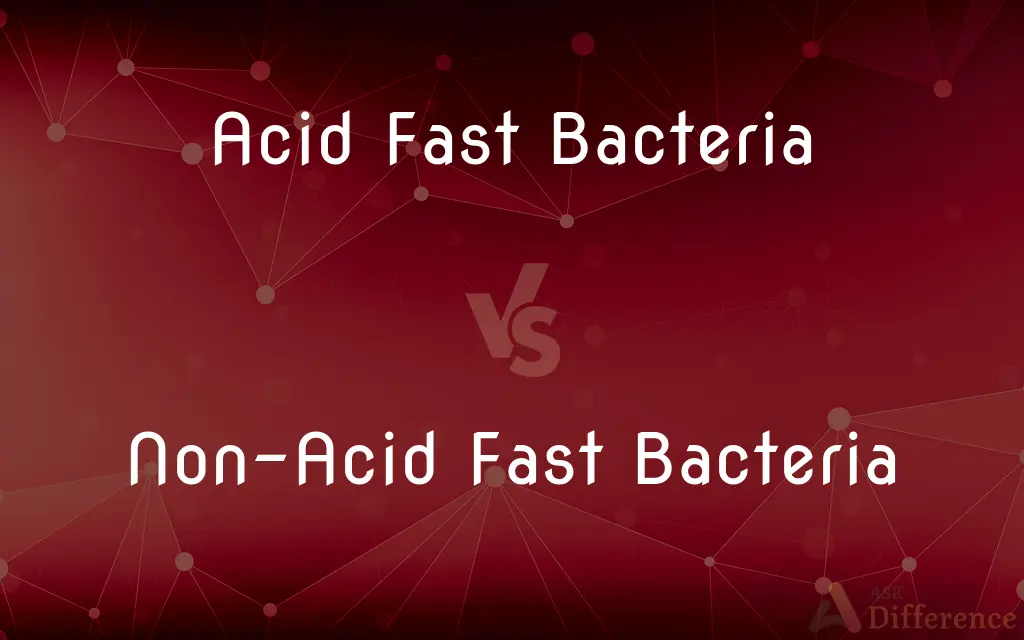Acid Fast Bacteria vs. Non-Acid Fast Bacteria — What's the Difference?
By Tayyaba Rehman — Published on January 16, 2024
Acid Fast Bacteria retain certain dyes even after acid washing due to a waxy cell wall, unlike Non-Acid Fast Bacteria which lose the dye under acidic conditions.

Difference Between Acid Fast Bacteria and Non-Acid Fast Bacteria
Table of Contents
ADVERTISEMENT
Key Differences
Acid Fast Bacteria, such as Mycobacterium tuberculosis, have a unique cell wall structure rich in mycolic acid, which makes them resistant to decolorization by acids. Non-Acid Fast Bacteria lack this waxy cell wall component, making them unable to retain the dye when exposed to acid.
In diagnostic staining, Acid Fast Bacteria remain colored after treatment with acid-alcohol, a characteristic used to identify pathogens like tuberculosis. Non-Acid Fast Bacteria, in contrast, lose their stain, indicating a different cell wall composition, aiding in differentiating bacterial types.
Acid Fast Bacteria are typically more resistant to disinfectants and antibiotics due to their robust cell walls. Non-Acid Fast Bacteria, with less complex cell walls, are generally more susceptible to these treatments.
The detection of Acid Fast Bacteria is crucial in the diagnosis of certain diseases like leprosy and tuberculosis. Non-Acid Fast Bacteria encompass a broader range of bacteria, including many common, less resistant strains.
Acid Fast Bacteria often require specialized treatment approaches due to their resilience. Non-Acid Fast Bacteria, being more responsive to standard treatments, are less challenging in this regard.
ADVERTISEMENT
Comparison Chart
Cell Wall Composition
High mycolic acid content, waxy and robust.
Lack mycolic acid, simpler structure.
Staining Characteristics
Retain dye after acid washing (acid-fast).
Lose dye under acidic conditions (non-acid-fast).
Disease Association
Often associated with serious diseases like TB.
Include a wide range of common bacterial strains.
Resistance to Treatment
Generally more resistant to antibiotics.
Typically more susceptible to treatments.
Diagnostic Importance
Crucial in diagnosing diseases like leprosy.
Useful in differentiating bacterial types.
Compare with Definitions
Acid Fast Bacteria
Characterized by a waxy cell wall containing mycolic acid.
Acid fast bacteria are challenging to treat due to their robust cell walls.
Non-Acid Fast Bacteria
Bacteria that lose their stain in the presence of acid.
In the acid-fast staining procedure, non-acid fast bacteria do not retain the primary dye.
Acid Fast Bacteria
Identified through specific staining techniques like Ziehl-Neelsen.
In the lab, acid fast bacteria stained bright red, distinguishing them from other bacteria.
Non-Acid Fast Bacteria
Identified by their inability to retain dye in acid-fast staining.
The lab results showed a predominance of non-acid fast bacteria in the sample.
Acid Fast Bacteria
Associated with serious diseases such as tuberculosis and leprosy.
The diagnosis of certain diseases involves testing for acid fast bacteria.
Non-Acid Fast Bacteria
Include a wide variety of common bacterial strains.
Streptococcus and Staphylococcus are examples of non-acid fast bacteria.
Acid Fast Bacteria
Bacteria that retain dyes even when exposed to acidic conditions.
Mycobacterium tuberculosis, an acid fast bacterium, is the causative agent of tuberculosis.
Non-Acid Fast Bacteria
Typically have simpler cell wall structures without mycolic acid.
Non-acid fast bacteria are more susceptible to antibiotics due to their less complex cell walls.
Acid Fast Bacteria
Resistant to certain antibiotics and disinfectants.
The acid fast nature of some bacteria makes them hard to eradicate.
Non-Acid Fast Bacteria
Easier to treat with standard antibiotics and disinfectants.
Non-acid fast bacteria can usually be effectively treated with conventional antibiotics.
Common Curiosities
Why are acid fast bacteria more resistant to treatment?
Their waxy cell wall makes them less permeable to antibiotics and disinfectants.
What staining technique is used for acid fast bacteria?
The Ziehl-Neelsen staining method is commonly used to identify acid fast bacteria.
Can non-acid fast bacteria be harmful?
Yes, non-acid fast bacteria can be pathogenic and cause various infections.
What makes bacteria acid fast?
The presence of a waxy, mycolic acid-rich cell wall makes bacteria acid fast.
What is the primary difference in the cell walls of these bacteria types?
Acid fast bacteria have a waxy cell wall with mycolic acid, unlike non-acid fast bacteria.
Can non-acid fast bacteria resist acid washing in staining?
No, non-acid fast bacteria lose their stain when exposed to acid.
What diseases are commonly associated with acid fast bacteria?
Tuberculosis and leprosy are commonly associated with acid fast bacteria.
Are all acid fast bacteria dangerous?
While many are pathogenic, not all acid fast bacteria are necessarily harmful.
How are non-acid fast bacteria treated?
They are generally treated with standard antibiotics and disinfectants.
Is the acid fast characteristic important for diagnosis?
Yes, it's crucial in diagnosing diseases like tuberculosis and leprosy.
What safety precautions are necessary when handling acid fast bacteria?
Strict laboratory safety protocols are required due to their potential pathogenicity.
Are there vaccines against acid fast bacterial infections?
Yes, for some diseases like tuberculosis, vaccines are available.
Are acid fast bacteria common in the environment?
They are less common in the environment compared to non-acid fast bacteria.
How is the presence of non-acid fast bacteria detected?
Through staining methods that show their inability to retain dye under acidic conditions.
Can both types of bacteria be found in the human body?
Yes, both types can inhabit the human body, with varying impacts on health.
Share Your Discovery

Previous Comparison
Aqua Blue Mini Pebble vs. Aqua White Mini Pebble
Next Comparison
Hindu Dharma vs. Sanatana DharmaAuthor Spotlight
Written by
Tayyaba RehmanTayyaba Rehman is a distinguished writer, currently serving as a primary contributor to askdifference.com. As a researcher in semantics and etymology, Tayyaba's passion for the complexity of languages and their distinctions has found a perfect home on the platform. Tayyaba delves into the intricacies of language, distinguishing between commonly confused words and phrases, thereby providing clarity for readers worldwide.














































